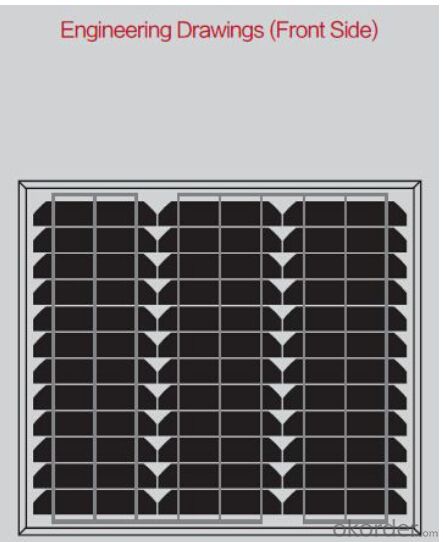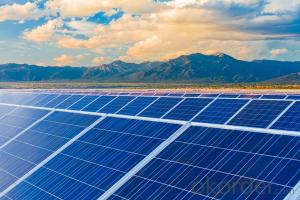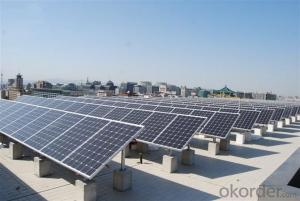Monocrystalline Solar Panels-30W-Apply to solar systems
- Loading Port:
- Shanghai
- Payment Terms:
- TT or LC
- Min Order Qty:
- 10000 watt
- Supply Capability:
- 50000000 watt/month
OKorder Service Pledge
OKorder Financial Service
You Might Also Like
Product Description
Solar Monocrystalline Series Panels
Introduction of Monocrystalline Solar Panels
CNBM Solar photovoltaic (PV) Panel is designed for large electrical power requirements. It is the optimal choice for both on-grid and off-grid power systems. CNBM Solar panel offers high performance of power per square foot of solar array. Monocrystalline silicon(c-Si): often made using the Czochralski process. Single-crystal wafer cells tend to be expensive, and because they are cut from cylindrical ingots, do not completely cover a square solar cell module without a substantial waste of refined silicon. Hence most c-Si panels have uncovered gaps at the four corners of the cells.
Characteristics of Monocrystalline Solar Panels
I Solar Cell : High efficiency crystalline solar cell. Even if under the weak light, the solar module can produce maximum power output.
II Tempered glass (toughened glass): Anti-reflecting coating and high transmission rate glass increase the power output and mechanical strength of solar module.
III EVA and TPT: Using high quality EVA and TPT to prevent destroying and water.
IV AI frame: Without screw, corner connection. 6 holes on the frame can be installed easily.
V Junction box: Multi function junction box with water proof.
VI Long lifetime: ≥25 years; Less power decrease
VII Good performance of preventing from atrocious weather such as wind and hails.
VIII Resisting moisture and etching effectively, not effected by geology.
Standard Test Conditions of Monocrystalline Solar Panels
The opto-electrical specifications shown below are stabilized values being measured at Standard Test Conditions, Irradiance: 1000W/m2, Spectrum: AM1.5 at 25°C, The info below is subject to manufacturing tolerances. Where appropriate minutes of measurement are available and are used for the dimensioning of the installation.
Advantages of Monocrystalline Solar Panels
1.High reliability with guaranteed -3% to +5% power output tolerance, ensuring return on investment
2. High conversion efficiency based on leading innovative photovoltaic technologies
3. Withstands high wind-pressure and snow load, and extreme temperature variations
4. Attractive appearance Unique frame design, high mechanical strength, and easy Installation
Characteristics of Monocrystalline Solar Panels
Max Power Voltage Vmp (V) | 17.6V | 17.2 V |
Max Power Current Imp (A) | 1.71A | 2.33A |
Open Circuit Voltage Voc (V) | 22.6V | 22.2V |
Short Circuit Current Isc (A) | 1.83A | 2.48A |
Max Power Pm (W) | 30W | 40W |
Temperature Coefficient of Cells
NOCT | 47℃±2℃ |
Temperature Coefficients of Isc (%/℃) | 0.06 |
Temperature Coefficients of Voc (%/℃) | -0.33 |
Temperature Coefficients of Pmp (%/℃) | -0.45 |
Mechanical Data Solar Monocrystalline Series
Power | 90W/100W |
Dimension | 510×450×25mm/610×510×25mm |
Weight | 2.7 kg/ 3.7kg |
Tolerance | ±3% |
The dimension of the modules can be changed according to the demand of clients Limits.
Operating Temperature | –45 °C to +80°C |
Storage Temperature | –45 °C to +80°C |
Max System Voltage | 700V |
Guarantee Solar Monocrystalline Series Panels
Products Guarantee | 2 years free from defects in materials and workmanship |
Performance Guarantee | No less than 90% within 10yrs and no less than 80% within 25yrs |
Certificates | IEC, ISO, TUV, CE |
Dimension of Solar Monocrystalline Series Panels


FAQ
We have organized several common questions for our clients,may help you sincerely:
1. What’s price per watt?
A: It’s depends on the quantity, delivery date and payment terms of the order. We can talk further about the detail price issue. Our products is high quality with lower price level.
2. Can you tell me the parameter of your solar panels?
We have different series of cells with different power output, both from c-si to a-si. Please take our specification sheet for your reference.
3. How do you pack your products?
We have rich experience on how to pack the panels to make sure the safety on shipment when it arrives at the destination.
4. What is your warranty system?
Our product performance guarantees for 25 years
• 12 years guarantee for workmanship
• Timeliness of delivery
• Quality Products certified (TÜV, UL, CE, ISO)
5. How do you pack your products?
We have rich experience on how to pack the panels to make sure the safety on shipment when it arrives at the destination.
It wasn't too long ago that the idea of generating electricity from the sun was a scifi dream, when it did become a reality it was mostly seen in small appliances, such as the humble desk top calculator. The sheer cost of solar panels for generating an alternative electricity supply for the home put the idea way beyond the reach of most home owners. But today, as solar cells are easier and cheaper to produce, solar panels are more popular. Of course, this interest is driven by a steady increase in the cost of National Grid power and a growing awareness of the damage traditional methods of power generation does to the environment.
Solar panels are created from multiple solar cells, the more energy we want to generate, the bigger the panel and the more cells we need. A solar cell is usually made from slices of silicon, the same as used in a CPU, which are mounted underneath a non reflective base, usually glass. Each solar cell generates a small current. However, if we link a sufficient number of these cells together we can increase the current proportionally. In this way we can increase the wattage to a level high enough to at least partially support an average household's electric usage, or even end their dependency on the local cable electricity supply.
So in short, when light strikes silicon it creates a small current, this current can be increased by linking many cells together in a panel. A solar panel. If you want more electricity, you simply add more panels.
There is a mathematical formulae for calculating the amount of watts generated so installers can easily estimate how many panels you want once they know your electricity consumption.
There are a couple of ways to have solar energy run your house, one is by installing ready made panels, bought from a hardware shop. You can have a trades person install them or do it yourself.
DIY is the second alternative to connecting your power needs to the sun, with a few tools a little knowledge of carpentry and common sense. You will need to buy solar cells, but after that you can build your own solar panels with very little effort.
- Q:Can anyone tell me how to connect a solar panel from a calculator to a motor from an RC car.
- Connecting them is not a problem: the solar cell has two leads or terminals, and so does the motor. The problem is that the panel from the calculator cannot supply very much current, and you need quite a bit for the motor. Also, the voltage is probably not more than 3 volts, and the motor needs probably six to twelve volts. If you have a voltmeter, check the output from the solar cell. You can get solar cells that will put out more current, but they will be bigger than the ones used for calculators. Even with these, you will probably need several in series to get enough voltage for the motor.
- Q:Can solar panels be used in areas with high levels of hurricanes?
- Yes, solar panels can be used in areas with high levels of hurricanes. However, it is important to ensure that the solar panels are properly installed and secured to withstand the strong winds and potential debris that hurricanes can bring. Additionally, selecting hurricane-resistant solar panels and implementing proper maintenance and inspection procedures can help to mitigate potential damage and ensure their long-term functionality in these areas.
- Q:How do solar panels impact the environment?
- Solar panels have a positive impact on the environment as they generate clean and renewable energy without emitting greenhouse gases or other pollutants. They help reduce our reliance on fossil fuels, decrease air pollution, and mitigate climate change by curbing carbon emissions. Additionally, solar panels require minimal water usage compared to other energy sources and have a long lifespan, making them an environmentally sustainable solution for electricity generation.
- Q:i'm talking abt bulk panelling, how many MW do we get from km sq?
- Solar panels are being improved on a continuing basis. Price is coming down and performance is going up. Still, they are expensive. A panel roughly /2 X /2 meter runs about $00. It generates 0 watts of power. To make a panel km square would take 4000 of these at a cost of $400,000. They would generate 40,000 watts or 40 kw or 0.04 Mw.
- Q:Would it be possible to use a lens or a mirror to focus light onto a solar panel in order to make in more efficient? And is something like this already being used? It was just a thought and I haven't spent much time on it, but I figured I'd ask.
- yes it is being done. i've seen adds for such a system. on the other hand, if you had a 5 sq in Lens focused on a small cell, and a 5 sq in cell, they'd be about the same. in fact, the cell might be a bit better because (A) there wouldn't be any loss in the Lens, and (B) it might be that the solar cell would use some frequencies to which the Lens was opaque. in addition, the cost of solar cells is dropping, making the cost of the mirrors or lenses uneconomical by comparison.
- Q:Are there any tax credits available for installing solar panels?
- Yes, there are tax credits available for installing solar panels. The federal government offers a Solar Investment Tax Credit (ITC) that allows homeowners and businesses to deduct a certain percentage of the cost of their solar panel system from their taxes.
- Q:Can solar panels be used in areas with extreme temperatures?
- Yes, solar panels can be used in areas with extreme temperatures. While extreme heat can reduce the efficiency of solar panels, modern solar technologies are designed to withstand high temperatures. Similarly, solar panels can also operate in extremely cold temperatures, although their performance may be slightly affected. Overall, solar panels can still generate electricity effectively in areas with extreme temperatures.
- Q:Can anyone give me some info on how to figure how many panels needed for a 0 volt 2 amp pool motor. Thanks/ Run 5 hours a day
- I don't think heating a 70,000 gallon pool with solar panels is practical. My husband has designed and built our solar hot water system. It works quite well. We live in Arizona. There's no way we could heat that much water using sun energy. You have to heat the water and compete with the outside air.
- Q:I was thinking about getting some GE Solar Panels and on there website that I am on, I didn't really see a price. can anybody give me maybe an estimate on how much each one would cost? thanks
- Retail, between $5 to $6 /watt.
1. Manufacturer Overview |
|
|---|---|
| Location | |
| Year Established | |
| Annual Output Value | |
| Main Markets | |
| Company Certifications | |
2. Manufacturer Certificates |
|
|---|---|
| a) Certification Name | |
| Range | |
| Reference | |
| Validity Period | |
3. Manufacturer Capability |
|
|---|---|
| a)Trade Capacity | |
| Nearest Port | |
| Export Percentage | |
| No.of Employees in Trade Department | |
| Language Spoken: | |
| b)Factory Information | |
| Factory Size: | |
| No. of Production Lines | |
| Contract Manufacturing | |
| Product Price Range | |
Send your message to us
Monocrystalline Solar Panels-30W-Apply to solar systems
- Loading Port:
- Shanghai
- Payment Terms:
- TT or LC
- Min Order Qty:
- 10000 watt
- Supply Capability:
- 50000000 watt/month
OKorder Service Pledge
OKorder Financial Service
Similar products
New products
Hot products
Hot Searches
Related keywords































